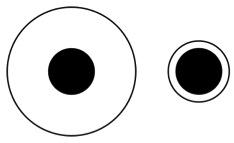Monkeys perceive visual illusions in the same way great apes and humans see them, according to researchers at Georgia State University.
The findings, published in the Journal of Experimental Psychology: Animal Learning and Cognition in August, indicate humans and monkeys perceive and misperceive the world similarly, which reflects resemblances in these species’ perceptual systems and their interpretation of their physical worlds.
In the study, capuchin monkeys and rhesus monkeys saw the Delbouef illusion in a manner similar to human adults. Visual illusions emerge when information is misperceived on the basis of surrounding context or presentation style. The Delboeuf illusion is one type of visual illusion where a dot surrounded by a large ring is typically perceived by humans to be smaller than the same-sized dot surrounded by a small ring. This occurs because the ring creates a specific context in which the dots are perceived.
The Delboeuf illusion has been studied extensively in humans, but previously, only one study has presented this illusion to an animal species.
“These results, along with others, show that humans and monkeys share similarities in their perceptual systems,” said Audrey Parrish, a graduate student at Georgia State who conducted the research as part of her doctoral dissertation. “They perceive and misperceive some types of physical stimuli in similar ways. Although these results do not mean that primates and nonhuman primates see their worlds identically, they do show that monkeys are an appropriate model for studying human perception and that contextual cues affect perception in ways that are shared across species.”
The research team conducted two computer experiments with human adults and monkeys. Humans were tested at individual computer stations with a personal computer, digital monitor and computer mouse. They were rewarded for correct answers with written feedback on their computer screen. Monkeys were trained to use joysticks for computerized testing and completed tasks with a system consisting of a color monitor, personal computer, digital joystick and food pellet dispenser. Correct responses were rewarded with banana-flavored pellets.
In the first experiment, monkeys and humans completed a computer task that required them to choose the larger of two central dots that were sometimes surrounded by the Delboeuf rings. Humans perceived the Delboeuf illusion, overestimating central dots when small rings surrounded them and underestimating the size of central dots when large rings surrounded them. Monkeys, on the other hand, did not show evidence of the illusion. The researchers were concerned that the monkeys had used outer ring size during the dot judgments, rather than the dot alone. To address this concern, they ran a second experiment.
In the second experiment, monkeys and humans played a computer game in which they were required to classify a central dot as small or large. Sometimes, a thin ring of variable size surrounded the dot. The researchers found evidence of the Delboeuf illusion in all three species. Capuchin monkeys and rhesus monkeys, like humans, classified dots presented inside large rings as small more often than the same-sized dots presented inside small rings. This showed that the context created by the ring, which was supposed to be ignored, generated a visual illusion. Monkeys and humans alike misperceived dot size depending on outer ring size.
Collaborators for this project include Michael Beran, associate professor in Georgia State’s Department of Psychology and associate director of the Language Research Center, and Sarah Brosnan, associate professor in Georgia State’s Department of Psychology, Department of Philosophy, Neuroscience Institute and Language Research Center.
In a previous study about the Delboeuf illusion by Parrish and Beran, chimpanzees were presented with two circular food items, each on a circular plate, to mimic the central dots and outer rings characteristic of the visual illusion. They could choose one food item for consumption. When plates were the same size, chimpanzees were excellent in choosing the larger food portion. However, when different-sized plates were used, food sizes were misperceived. Chimpanzees preferred the same-sized food off a small plate versus a large plate and sometimes chose a smaller amount of food on a small plate versus a larger amount of food on a large plate. Similar results were reported in humans. This study was published in Animal Cognition.


